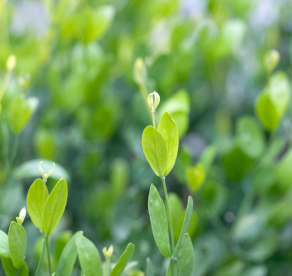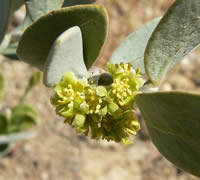Jojoba Simmondsia chinensis

Young jojoba leaves
- Common Names
- Jojoba Oil
- Botanical Name
- Simmondsia chinensis
- Family
- Buxaceae
Medicinal Uses & Benefits of Jojoba Oil
![]() How to Use|
Side Effects |
Plant & Garden|
How to Use|
Side Effects |
Plant & Garden|
- Medicinal Uses: * Beauty
* Facial Care
* Massage Oils
* Skin Care
- Properties: * Emollient * Skin tonic
- Parts Used: Seed wax
- Constituents: fatty acids
How to Use: Jojoba
The structure of jojoba oil closely resembles that of your own skin sebum, your skin's own lubricating medium. This gives jojoba a natural affinity to the skin, and is readily absorbed without making the skin feel greasy or tacky nor does it clog the pores. It has exceptional skin-softening properties, as well as the ability to minimize fine lines and wrinkles, promoting skin suppleness while assisting with the rejuvenation of the skin. You will find jojoba oil is many high-end anti-aging creams and lotions, but the oil stands well on it's own in skin care and is a favorite carrier oil in aromatherapy.
Preparation Methods & Dosage :Use jojoba oil as a skin care treatment, massage oil and carrier oil for aromatherapy oils.
Jojoba Remedies
Plant Description

Male Flowers
- Flowers: Small, greenish-yellow, with 5-6 sepals and no petals.
- Plant Class:Perennial Shrub
- Leaves:Oppostie, oval leaves, thick, waxy and gray-green in colore
- Fruit: Acorn shaped seed matures into a hard, dark brown oval. This seed contains a liquid wax that is used in aromatherapy and skin care.
- Preferred Habitat:Desert
- Flowering Season:
- Distribution: Southwestern deserts of the US and Mexico
Regional Traditions :North America *











